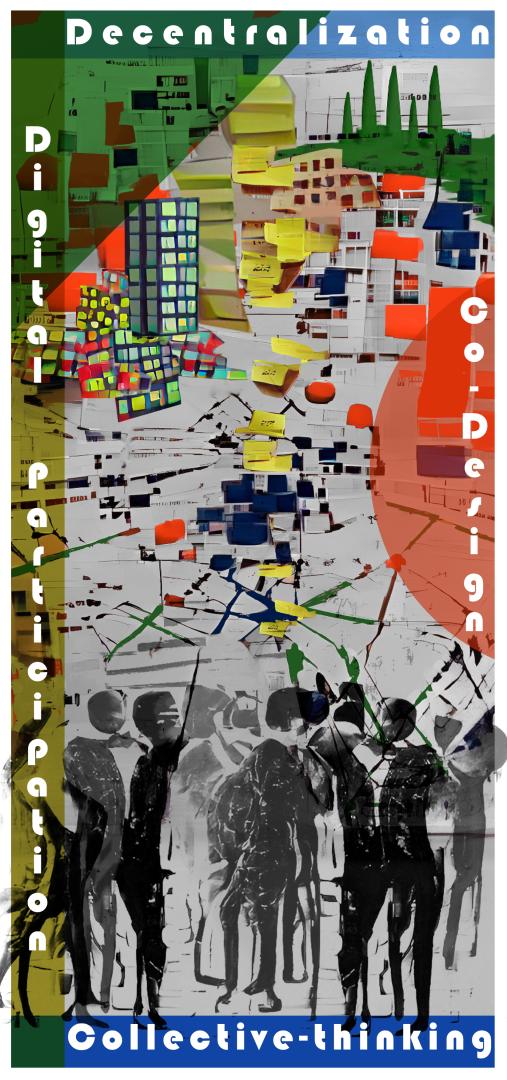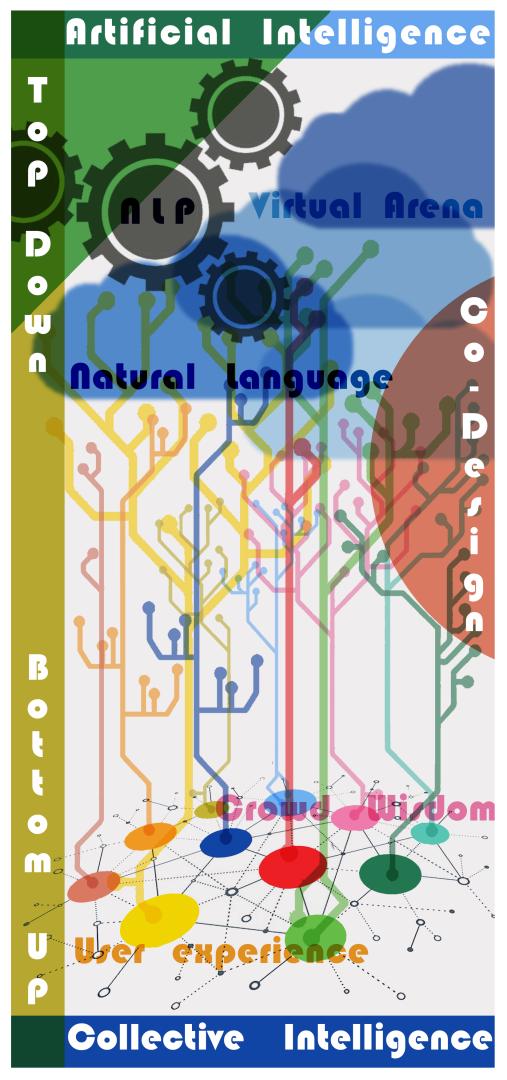Natural Language Processing & Co-design
Basic information
Project Title
Full project title
Category
Project Description
The project proposes a Digital Participation Platform paired with Natural Language Processing tools to harness the large-scale collective intelligence of citizens contained in textual information produced in online public consultations, improving legitimacy, transparency, and inclusiveness of the public decision-making process. The alignment of large-scale public engagement with Participatory and Co-design aims to address social, economic, and environmental challenges in the built environment.
Geographical Scope
Project Region
Urban or rural issues
Physical or other transformations
EU Programme or fund
Which funds
Description of the project
Summary
The proposed Digital Participation Platform combined with Natural Language Processing (NLP) technology, aims to enhance citizens involvement in Participatory and Co-design processes supporting the sustainable transformation of the built environment. The Digital support for public participation activities aims to promote large-scale collective thinking, letting the citizens to be active actors strengthening the access and participation in the decision-making process in a more inclusive and transparent way. Public participation initiatives typically involve a small group of citizens, instead, the use of a Digital Platform allow engaging a larger-scale public participation by means to which they are nowadays accustomed by social platforms. Citizens are allowed to express in natural language their values, needs and shared interests. Natural language is the most pervasive and richest form of knowledge expression and at the same time it is difficult to manage and valorize. In fact, the amount of natural language information that can be collected via the Digital Platform makes the information overload a key challenge to overcome to enhance public participation. As a result, the use of NLP systems, based on the latest Artificial Intelligence algorithms, is proposed to surface the contribution of the collective intelligence and valorize the contributions of citizens and areas in situations of economic, social, and environmental distress. The citizens, daily users of the built and natural space, will be the creators of the sense of responsibility and belonging required for the preservation of the identities of places, reversing the current top-down approach of social and supporting ecological policies. The project aims to create a meeting point between the policy maker and citizens, promoting a mindset shift and the opportunity to co-create services and products to support the sustainable transition of the built environment in a decentralized and more democratic way.
Key objectives for sustainability
Starting from the concept that the “user is the main expert of his/her context”, the main source of information to direct and manage change in a sustainable perspective should come from the citizen, the user that experience every day of the neighborhood-built environment. The proposed Digital platform-based public consultation process supported by NLP tools can encourage citizens elicitation of shared interests and values fostering large-scale collective thinking, creating new ideas about how transform the city and how to lead communities towards spaces that can support the environmentally, economically, and socially sustainable transition. The information and knowledge about user/citizen need and context of application will help technical experts (e.g. product and service designers, architects, and urban planners) and policy makers to provide life-citizens centered and circular services, and products. The active involvement of citizens in the management and transformation of the built and natural environment supports the creation of a sense of accountability by reversing the current top-down approach of sustainable policies by creating a link between citizens' demands (bottom-up approach) and sustainable and circular economy policies (top-down approach). As a result, the Digital Participation Platform combined with NLP tools for public participation processes will create an exchange virtual arena where public participation and Participatory and Co-design methods can meet, fostering a mindset shift and the opportunity to Co-create sustainable services and products to support the circular transition. Citizens, having the opportunity to express their wish to conserve, restore and positively transform the environment, would be the main actors in the construction of a shared sense of common responsibility no longer imposed by the legislator. The ideas will be ranked according to sustainability values to increase participants awareness.
Key objectives for aesthetics and quality
A Public consultation process can be defined effective and with a high-quality level if characterized by:
- Good level of participation and involvement of users/ citizens in the process.
- Collaborative processes centered on common interests (i.e. values expressed by the citizenry).
- Transparency and objectivity of information gathering and communication.
- Good level of information sharing to inform participants and support shared decision-making to avoid/resolve possible conflicts.
- Deliberative models of communication that foster communication between parties and between policy makers and citizens.
- Engagement strategies aimed at representing different stakeholders (economically or socially distressed individuals) and avoiding biases.
The development of Digital Participation Platform combined with NLP technology will increase the public participation on a large-scale to centralize citizens’ values, needs, and interests as part of a citizen life-centered solutions design process for new products, services, and infrastructure to support the sustainable transition. The integration of the online public consultation with NLP automated analysis will be more objective, avoiding possible risks of misinterpretation, decontextualization and information overload in favor of greater transparency and neutrality of the process. The proposed methodology aims to support the overlapping between the mechanisms of public participation and Participatory and Co-design approach by emphasizing the active role of the citizens fostering a bidirectional communication between the citizen and the policy maker in a shared virtual environment where transparent decision-making process is the common goal. The expanded audience will encourage the participation of the economically or socially disadvantaged citizens and the inclusion of diverse stakeholders avoiding biases, and better representing the community involved in the transformation of the specific built and natural environment.
Key objectives for inclusion
The Participatory and Co-design approach involves engaging the users as a design partner by allowing them to be active participants. In this process, technicians (e.g., product and service designers, architects, and urban planners) and policy makers become mere facilitators. From this point of view, the mechanisms of public participation overlap with the theory of Participatory and Co-design, both aim to enhance the role of the user in the decision-making process supporting the expression of collective values and needs during forums and workshops. From this perspective, the objective of the proposed system is to expand the number of users compared to a traditional public consultation while allowing a more transparent and objective management and analysis of the results by exploiting the capacity of modern NLP systems at processing and identifying users' tacit knowledge, the so called “crowd wisdom”. The proposed approach aims at including citizens collective intelligence and knowledge of the built environment in the design process, driving communities needs at the center, decentralizing the decision-making process. The large-scale public participation allowed by Digital Participation Platform combined with the ability to process and manage textual data of modern NLP systems can also valorize the contribution of specific citizens and areas in situations of economic, social, and environmental distress in a participatory and inclusive process. In order to include people with social and economic disadvantages, who may have difficulties accessing the Digital platform, shared-use devices, access points, and a targeted communication and awareness campaign will be ensured to maximize the inclusiveness of the process. Open discussions and interaction among citizens on the Digital Participation Platform will also foster peer-learning processes making the community more aware about reasons and possible positive or negative impacts of interventions on the built environment.
Physical or other transformations
Innovative character
The main goal of the project is the valorization of the collective intelligence in a large-scale thinking and crowdsourced way to improve the sustainable preservation, management, and transformation of the natural and built environment. The Digital Participation Platform combined with NLP technology will allow the citizen to express in natural language their values, needs and shared interests. Natural language (e.g., short texts and written sentences) is the most pervasive, common, and richest form of knowledge expression. The NLP technologies will be adopted in the Digital Platform to analyze and prioritize the actions and defining strategies based on citizens’ input, letting the communities to lead the sustainable and circular transition defining their own sense of belonging, providing local solution to global challenges. In such a vision, policy maker, technicians and citizens are on the same level as design partners; citizen can in fact provide priceless experience-based knowledge about the social, economic, and environmental context proposing and supporting interventions on the built and natural environment. At the same time, the proposed Digital Platform can be perceived and used as an educational environment by the participants in a peer-learning process, making the community aware about reasons, impacts of interventions, driven by specialized competences. The overlap between public participation and Participatory and Co-design approach is the main contribution of the project which will foster a bidirectional communication between the citizen and the policy maker in a shared and more transparent and democratic decision-making process, reversing the current top-down approach which has been characterized the traditional management and transformation of the built environment. The project aims to fill the gap between citizens and policy makers and technicians and in general, with the democratic process which has seen a decrease in participation and trust.


